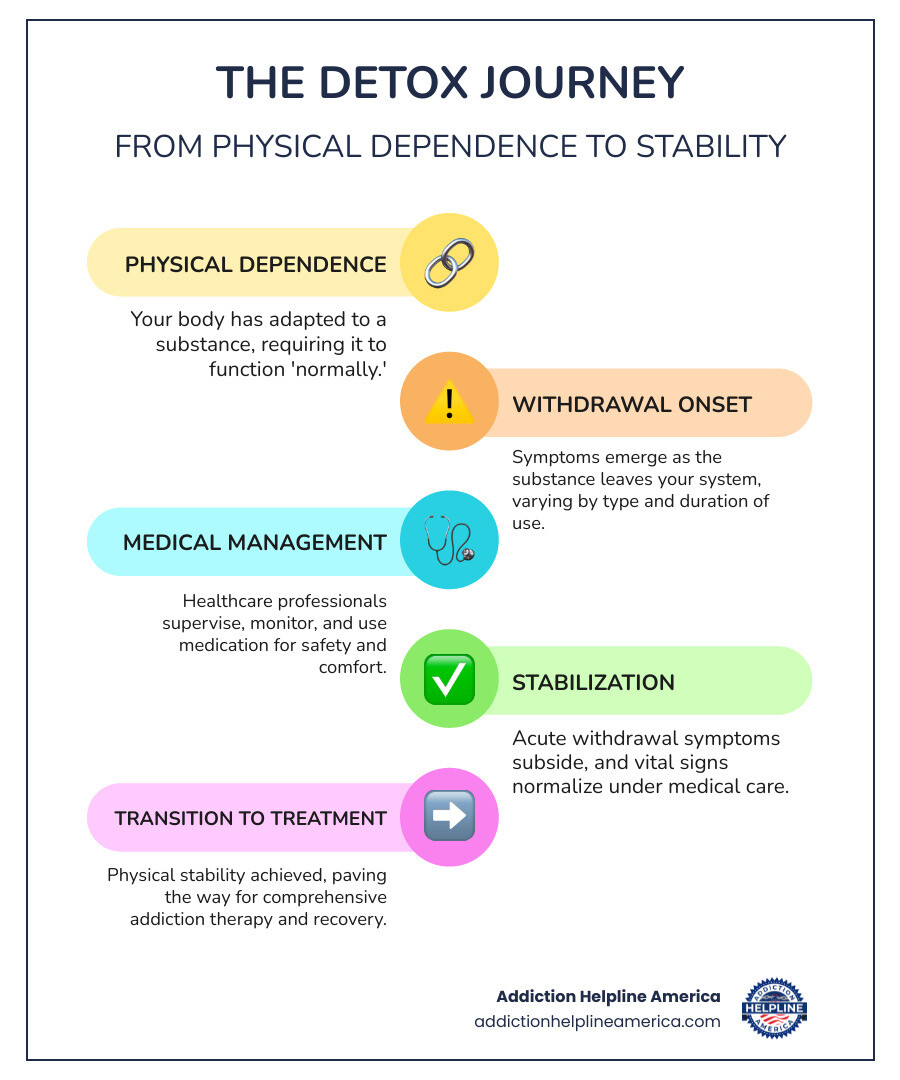Your Journey to a Healthier Life Starts Here
Free Insurance Verification
Verify Your Treatment Coverage
Verify Your Treatment Coverage
Drug detox is the process of safely removing drugs or alcohol from your body while managing the withdrawal symptoms that occur when you stop using. It is the critical first step in addiction treatment, designed to help you become medically stable before beginning longer-term recovery programs. However, detox is not the same as rehab. It only addresses physical dependence, while full recovery requires therapy and support to address the underlying causes of addiction.
Quick Facts About Drug Detox:
When you stop using a substance after developing physical dependence, your body goes into withdrawal. Symptoms can range from uncomfortable (nausea, anxiety) to dangerous (seizures, delirium tremens). For substances like alcohol and benzodiazepines, quitting “cold turkey” can be fatal. This is why medical supervision is essential—healthcare professionals monitor your vital signs, manage symptoms with medication, and intervene if complications arise.
At Addiction Helpline America, we’ve guided thousands of individuals through the detox process, connecting them with safe, effective drug detox programs custom to their needs. We understand this first step can feel overwhelming, and we’re here to provide compassionate support and clear information.

When you begin drug detox, your body must readjust to functioning without a substance it has become dependent on. This adjustment period, known as withdrawal, is why professional support is so important. A professional drug detox program is designed to manage withdrawal symptoms safely and make you as comfortable as possible.
Medical teams monitor you around the clock, provide medications to ease symptoms, and intervene immediately if complications arise. You don’t have to go through this alone.
Withdrawal symptoms vary widely depending on the substance, duration of use, and your individual health. Some people experience mild, flu-like discomfort, while others face severe anxiety, depression, and overwhelming cravings. The psychological symptoms, such as mood swings and intense cravings, can be just as challenging as the physical ones. These are not signs of weakness but chemical reactions in your brain as it heals.
Different substances create different withdrawal experiences. Understanding what to expect can help reduce anxiety about the process.
| Substance | Common Physical Symptoms | Common Psychological Symptoms | Typical Timeline | Specific Risks |
|---|---|---|---|---|
| Alcohol | Shaking, sweating, nausea, vomiting, headache, increased heart rate, tremors, diarrhea | Anxiety, irritability, mood swings, agitation, confusion, hallucinations | Symptoms peak within 24–72 hours, can last up to a week | Seizures, Delirium Tremens (DTs) (can be fatal, 37% mortality rate if untreated) |
| Opioids (e.g., Heroin, Fentanyl, Oxycodone) | Muscle aches, runny nose, watery eyes, sweating, yawning, diarrhea, nausea, vomiting, abdominal cramping | Anxiety, depression, restlessness, intense cravings, insomnia | Symptoms begin 6–30 hrs after last use, peak within 72 hrs, subside within a week (longer for methadone) | Severe discomfort leading to relapse, dehydration from vomiting/diarrhea |
| Benzodiazepines (e.g., Xanax, Valium, Klonopin) | Tremors, muscle spasms, sweating, headache, nausea, vomiting, heart palpitations, seizures | Severe anxiety, panic attacks, irritability, insomnia, paranoia, hallucinations, intense cravings | Symptoms begin 1–4 days after last use, peak in 2 weeks, can last weeks or months (PAWS) | Seizures, psychosis, Delirium Tremens (similar to alcohol) |
As the table shows, alcohol and benzodiazepine withdrawal are among the most dangerous and can be life-threatening without medical care due to the risk of seizures and Delirium Tremens (DTs). This is why a medically supervised detox is critical.
Opioid withdrawal, while rarely fatal, is uncomfortable and often described as a severe case of the flu. The extreme discomfort makes relapse highly likely without professional support.
For stimulants like cocaine or methamphetamine, withdrawal is primarily psychological, involving intense cravings, fatigue, and depression. While not typically medically dangerous, these symptoms can be emotionally devastating and pose a high risk of relapse.
There is no one-size-fits-all timeline for drug detox. The duration depends on several factors:
For most people, the acute withdrawal phase of drug detox lasts between 7 to 14 days. However, some symptoms can linger for weeks or months, a condition known as Post-Acute Withdrawal Syndrome (PAWS). These symptoms, including mood swings, sleep issues, and low energy, are a normal part of the brain’s healing process.
At Addiction Helpline America, we connect you with detox programs that understand these individual variations and provide the personalized support you need.
When you’re ready to start drug detox, you’ll need to decide on the right setting. The best choice depends on your level of physical dependence, the substance used, and your home environment. The most important factor is the level of medical supervision, which impacts your safety and comfort.
Choosing between inpatient and outpatient drug detox is about matching the program to your needs.
Inpatient detox provides 24/7 medical supervision in a specialized facility, typically for 5 to 14 days. This is critical for anyone withdrawing from alcohol or benzodiazepines, where withdrawal can be fatal. It offers a structured environment away from daily triggers, allowing you to focus completely on healing. While more expensive and requiring you to step away from daily life, it is the safest and most effective option for those with moderate to severe dependence, co-occurring disorders, or an unstable home environment.
Outpatient detox allows you to live at home while attending scheduled medical check-ins and support sessions. This flexible and less expensive option can work for people with milder dependence and a stable, supportive, drug-free home. However, it requires a high level of self-discipline to manage cravings and attend appointments without constant supervision.
Questions to ask when choosing a program:
At Addiction Helpline America, we help you find a program that fits your medical, personal, and financial needs.
Attempting drug detox at home without medical supervision is extremely dangerous. While the privacy and comfort of home may seem appealing, the risks can be life-threatening.
Quitting alcohol or benzodiazepines “cold turkey” can trigger seizures, delirium tremens (DTs), and other fatal complications. For other substances like opioids, severe dehydration and electrolyte imbalances from vomiting and diarrhea can lead to medical emergencies. The intense physical discomfort and psychological distress also create an overwhelming risk of relapse.
For your safety, a medically supervised program is the best choice. Your life is worth the investment in proper care. Addiction Helpline America can connect you with safe, effective detox options that fit your situation.
During drug detox, medical professionals are your lifeline. This approach, known as “withdrawal management,” is endorsed by leading health organizations like the World Health Organization (WHO) and the American Society of Addiction Medicine (ASAM). The primary goal is medical stabilization—keeping you safe and as comfortable as possible while your body adjusts.
Your medical team acts as your safety net. They conduct a thorough evaluation, continuously monitor your vital signs, manage your medications to prevent complications, and provide crucial emotional support. They also help you plan for what comes next, understanding that drug detox is only the beginning of your recovery journey.
A professional drug detox program follows three essential stages to ensure a safe and effective transition to recovery.
1. Evaluation: Your medical team performs a comprehensive assessment to create a personalized treatment plan. This includes testing for substances in your system, a full physical and mental health screening, and a review of your substance use history.


Take the first step towards a healthier life! Call now to connect with our compassionate team and start your recovery journey today. Your path to healing awaits!
Our recovery specialists are available 24/7 to provide support, and all calls are confidential and free. Reach out anytime – we’re here to help!
2. Stabilization: This is the core of the detox process, where you are guided through withdrawal with medical and psychological support. Medications are used to ease symptoms and prevent dangerous complications. You are monitored in a safe, supportive environment, allowing you to focus on healing.
3. Fostering Entry into Treatment: Detox alone is rarely enough for long-term recovery. This final stage prepares you for the next step. Your team educates you about addiction and helps you develop a long-term recovery plan, connecting you with resources like inpatient rehab, outpatient programs, or counseling.
Medication-Assisted Treatment (MAT) makes drug detox safer and more tolerable by reducing withdrawal severity and cravings. The specific medication depends on the substance.
These powerful medications require close medical supervision. At Addiction Helpline America, we connect you with programs that use MAT safely and effectively as part of a comprehensive treatment plan.
Completing drug detox is a monumental achievement, but it is the first step, not the final destination. Detox clears the substances from your body, but addiction is also a psychological and behavioral condition. The cravings, thought patterns, and triggers that led to substance use remain and must be addressed through continued treatment.
What comes after detox is just as critical as the detox itself. At Addiction Helpline America, we guide you from detox into comprehensive treatment programs that give you the best chance at lasting sobriety.
After drug detox, the work of rebuilding your life begins. This phase focuses on healing your mind, developing healthy coping skills, and creating a lifestyle that supports sobriety.
Relapse does not mean treatment has failed; it often means the treatment plan needs adjustment. We are here to help you find the right combination of support.
Alongside professional treatment, certain lifestyle practices can support your body’s healing process. These are complementary tools, not replacements for medical care.

If you are pregnant and using substances, seeking help is a brave and loving act for you and your baby. Drug detox during pregnancy requires highly specialized medical care.
Continued substance use can cause serious harm to the fetus, and abrupt cessation can cause severe fetal distress or death. Medical supervision is absolutely essential. A professional team can manage your withdrawal in a way that minimizes harm to both you and your baby.
We know this situation is frightening, but the medical professionals who specialize in this area are there to help, not judge. The sooner you seek help, the better the outcome. Addiction Helpline America can connect you with confidential programs designed for pregnant individuals. You and your baby deserve the healthiest start possible.
Navigating drug detox can be confusing. Here are straightforward answers to some of the most common questions we hear.
The cost of drug detox varies based on the type of program (inpatient is typically more expensive than outpatient), the length of stay, and the specific facility. However, cost should not be a barrier to getting help. Many payment options are available:
Don’t let financial worries stop you. We can help you explore every available option.
Finding the right drug detox center can feel like a challenge, but you don’t have to do it alone.
Your primary care doctor or a mental health professional is a great first resource. They know your health history and can often recommend trusted local providers.
You can also contact us at Addiction Helpline America. This is what we do. We provide free, confidential, and personalized guidance to connect you with the right treatment center for your specific needs. With our nationwide network, we can help you find a program that fits your location, budget, and treatment preferences. Making the first call is the most courageous step you can take.
This is a common and important question. The terms are often confused, but they represent two distinct stages of recovery.
Think of it this way: Drug detox is the emergency room. It addresses the immediate physical crisis by stabilizing you, managing acute withdrawal, and safely removing the substance from your body. It’s a short-term process, usually lasting a few days to two weeks.
Rehab is the comprehensive follow-up care. It’s like the physical therapy and long-term healing after the ER visit. Rehab addresses the psychological and behavioral aspects of addiction—the underlying causes, triggers, and thought patterns. It’s a longer-term process (30 days to several months) that equips you with the tools to maintain sobriety through therapy, counseling, and support.
In short: Detox is the first step, but rehab is the full treatment. Detox addresses physical dependence; rehab addresses the addiction itself and teaches you how to live a sober life.
Taking the first step toward drug detox requires immense courage. If you are reading this, you have already started the journey toward healing.
We hope this guide has clarified what drug detox involves and what it takes to build a foundation for lasting recovery. Here are the key takeaways:
At Addiction Helpline America, we have walked alongside thousands of people at this exact crossroads. We know how overwhelming this first step feels, and we are here to help. Our team provides free, confidential guidance to help you find the right detox program and treatment center for your needs. We are here to support you, not to judge.
Recovery is possible. A new beginning is waiting. You don’t have to take the next step alone.
Are you or a loved one struggling with addiction? Call today to speak to a treatment expert.
Calls to any general helpline will be answered or returned by one of the treatment providers listed, each of which is a paid advertiser:
Our helpline is available 24 hours a day, 7 days a week at no cost to you and with no obligation for you to enter into treatment. We are committed to providing support and guidance whenever you need it.
In some cases, Addiction Helpline America charges our verified partner a modest cost per call. This fee helps us cover the costs of building and maintaining our website, ensuring that we can continue to offer this valuable service to those in need.
Calls to the general helpline will be answered or returned by one of the listed treatment providers, all of whom are paid advertisers.
By using the helpline, you agree to the terms of use. We do not earn any commission or fee based on the treatment provider selected by the caller, and there is no obligation to pursue treatment.
This service is not affiliated with Alcoholics Anonymous World Services, Inc.